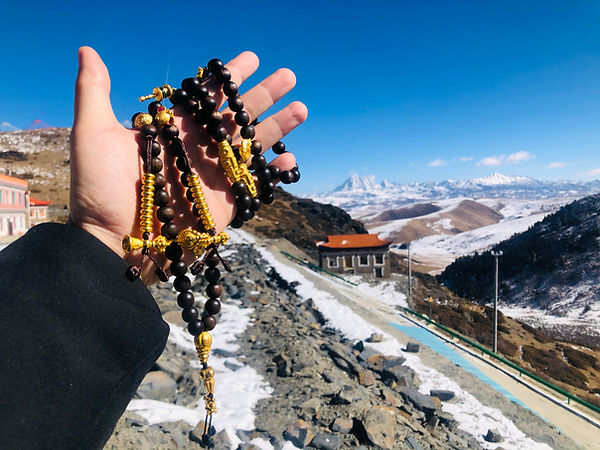
Tibetan Buddhist Prayer Beads (Mala, ཕྲེང་བ)
Beads in Tibetan Buddhism are not just objects of faith, but symbols that embody one’s spiritual journey. Traditionally comprising 108 beads, malas are used in the meditative recitation of mantras, each bead marking a prayer cycle.
This particular mala was assembled during travels across the Tibetan Plateau. Two long gold counting beads (བཅུ་གསལ) were acquired in Lhasa; two protective sky bead-shaped waist beads (གཟི) in Kangding; and a Dharma wheel ornament (འཁོར་ལོ) in Yulshul. The beads have also been blessed by two Living Buddhas (monks of high prestige. Each bead and ornament acts as a link between the wearer and the Buddhist cosmology.
Main Bead (བརྒྱ་དཔོན, brgya dpon)
The main bead, at the centre, represents wisdom and enlightenment that the wearer seeks to attain through meditation and learning of the Dharma (Buddhist cosmic law). In this case it has been paired with the lotus (པདྨ, péma), which represents purity and enlightenment, as well as a pair of hands clasped in prayer, associated with meditation.
Counting Beads (བཅུ་གསལ, bcu gsal)
Counting beads track mantra recitations—the cyclical movement of the beads reflecting the Buddhist cosmology of infinite endings and beginnings. Attached are lightning motifs (རྡོ་རྗེ།, dorje) symbolising indestructible faith, and a bell representing the clarity of the Dharma.
Chhatra (གདུགས, duk)
The Chhatra (parasol), symbolises the prestige of the Buddha. As one of the eight auspicious symbols of Buddhism, it is often paired with a victory banner or dhvaja (རྒྱལ་མཚན), absent from this set, which symbolises victory over temptations and hindrances on the path to enlightenment.
Conch (དུང་དཀར, dungkar)
The conch symbolises the resonant spread of the Dharma, awakening those ready to follow the Buddha’s path.
Dharma Wheel (འཁོར་ལོ, khorlo)
A central Buddhist motif, the ever-turning Dharma wheel symbolises the cyclical nature of the universe, where endings lead to new beginnings. It reflects the principle of karma—how past and present actions shape one’s future.
Endless Knot (དཔལ་བེའུ, pelbeu)
With its interwoven lines, the knot symbolises the interconnectedness of all things through the Dharma. It also reflects the transient nature of earthly temptations, bound within the enduring cycle of karma.
Golden Fish (གསེར་ཉ, sernya)
Fish, which move freely through water, symbolise the liberation from suffering attained through enlightenment. They are typically found in pairs, but the owner of this set acquired only one.
Bhumpa Vase (བུམ་པ།, bhumpa)
The vase is a symbol of infinity: not only of Buddha’s wisdom, but also the endlessness of the universe.